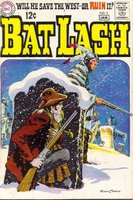
The long-running antagonists for the X-Men debuted in X-Men #14. An anthropologist named Dr Trask warns mankind that the mutants are among us and that they are a severe danger to mankind:

For starters, it seems unlikely that an anthropologist would be issuing this warning; anthropologists study other cultures and attempt to do so without making judgments about right and wrong (not always successfully, mind you). And later events in the story make the idea that Trask is an anthropologist very unlikely. For example, after Professor X demands a TV debate with Trask, the latter brings out his sentinels:

Okay, so now we've got an anthropologist who's skilled at making robots? Then again, maybe he's not all that skilled, for the Sentinels quickly turn against him:

This is possibly the biggest cliche of the Silver Age: robots and computers were constantly rebelling against their masters. Indeed, the series Magnus, Robot Fighter which I have discussed several times recently, is based on that premise. But there are many, many other examples, like Computo rebelling against Brainiac 5, or Wonder Man (one of Superman's robots) who briefly replaced Superman.
It also ties into one of the odder conundrums of the Silver Age. While there was enormous respect for "science", the writers were considerably more suspicious of technology (i.e., applied science). To a certain extent, this may be due to the shoddy workmanship of electronic devices of the time.
The X-Men race to the TV studio in response to a mental summons from Professor X. Most of the Sentinels leave with Trask, but one remains behind. The X-Men have a minor battle with it, when it inexplicably keels over:

Professor X hears the robot say something about a "Master Mold" before it collapses. He is also able to get an impression of the HQ of the Sentinels. The team heads there, but they get split up and the Sentinels start catching them:

Trask, now a prisoner of the Sentinels himself, learns of the real mission of the X-Men:

This story also tells us the origin of the Beast, aka Hank McCoy. His father worked at an "atomic project", as an ordinary laborer, which of course raises the question where Hank got his prodigious loquacity (of course, in the real world, he got it from Kirby's earlier "Big Words" character, who got it from "Johnny" in the Doc Savage series, who probably picked it up from somewhere else). Hank discovered that he had extraordinary agility, which he put to good use on the gridiron:

His extraordinary feats brought him to the attention of Professor X, who invited him to join the X-Men.
In the finale (X-Men #16), the team escapes from the prison where the Sentinels were holding them, and using teamwork are able to hold them off briefly. Meanwhile, Professor X has determined what stopped the original Sentinel in the TV studio; it was a crystal which interfered with the transmission signals from the Master Mold to the Sentinels. Professor X has the crystal flown to the Sentinel's headquarters. At the same time, the Master Mold is forcing Trask to create more Sentinels:

But at the last moment, Trask rebels:

Trask destroys the Master Mold and is killed in the process. The X-Men manage to escape the Sentinel's HQ via some solid teamwork.
Comments: A terrific and exciting tale with lots of excellent characterization. If the entire X-Men run had been as solid as this one, it would not have been canceled before the end of the Silver Age.
The stories described in this post have been reprinted here:









